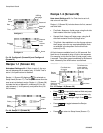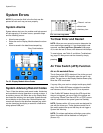
Setup Mode Details
48 3A0868G
Dynamic Dosing
In typical operation (ratios 1:1 and above), component A
dispenses constantly. Component B dispenses intermit-
tently in the necessary volume to attain the mix ratio.
General Operating Cycle, Dynamic Dosing
Overview
Dynamic Dosing provides on-demand proportioning,
eliminating the need for an integrator and therefore min-
imizing undesired material contact. This feature is espe-
cially useful with shear-sensitive and waterborne
materials.
A restrictor injects component B into a continuous
stream of component A. The software controls the dura-
tion and frequency of each injection. See F
IG
. 52 for a
schematic diagram of the process.
Dynamic Dosing System Parameters
The following parameters affect dynamic dosing perfor-
mance:
• Component A Flow: Ensure that the supply pump is
sized to provide sufficient and uninterrupted flow.
Note that component A provides majority of system
flow at higher mix ratios.
• Component B Flow: Ensure that the supply pump is
sized to provide sufficient and uninterrupted flow.
• Component A Pressure: Ensure precise pressure
regulation. It is recommended that the component A
pressure be 5-15% lower than the component B
pressure.
• Component B Pressure: Ensure precise pressure
regulation. It is recommended that the component B
pressure be 5-15% higher than the component A
pressure.
NOTE: When using dynamic dosing it is very important
to maintain a constant, well-regulated fluid supply. To
obtain proper pressure control and minimize pump pul-
sation, install a fluid regulator on the A and B supply
lines upstream of the meters.
Select a Component B Restrictor Size
If you cannot maintain the desired flow and spraying
ratio, you may need to select a different restrictor. Use
the charts on pages 61 to 65 to select an appropriate
restrictor size based on the desired flow and mix ratio.
Balancing A/B Pressure
If component B pressure is too high, it will push the com-
ponent A stream aside during B injection. The valve will
not open long enough, causing a Ratio High error.
If component B pressure is too low, it will not be injected
in sufficient volume. The valve will stay open too long,
causing a Ratio Low error.
Selecting the correct component B restrictor size and
balancing the A/B pressures will keep the system in the
proper pressure range, resulting in a consistent mix
ratio.
F
IG
. 50 shows the A to B pressure balance, read at the
proportioner inlet. It is recommended that the compo-
nent B pressure be 5-15% higher than the component A
pressure to keep the system in the control range, hold
the proper mix ratio, and obtain properly mixed material.
If pressures are not balanced (“B Pressure Too High” or
“B Pressure Too Low”), it may not be possible to hold
the desired mix ratio. The system will generate an off
ratio alarm and stop operation.
NOTE: In multi-flow rate systems, it is recommended
that you set up the system to run properly at the highest
flow rate, to ensure adequate fluid supply across the
flow rate range.
In dynamic dosing, component A dose valve is con-
stantly on. Component B dose valve will cycle on and
off; one cycle every 0.5 – 1.0 seconds indicates proper
balance.
Monitor system performance by watching the pressure
readings for each pump on Run Pump Control (Screen
15).
Warning messages also provide information on system
performance. Adjust pressures accordingly. See Table 2
on page 49.
F
IG
. 49. Monitor Pump Pressures


















